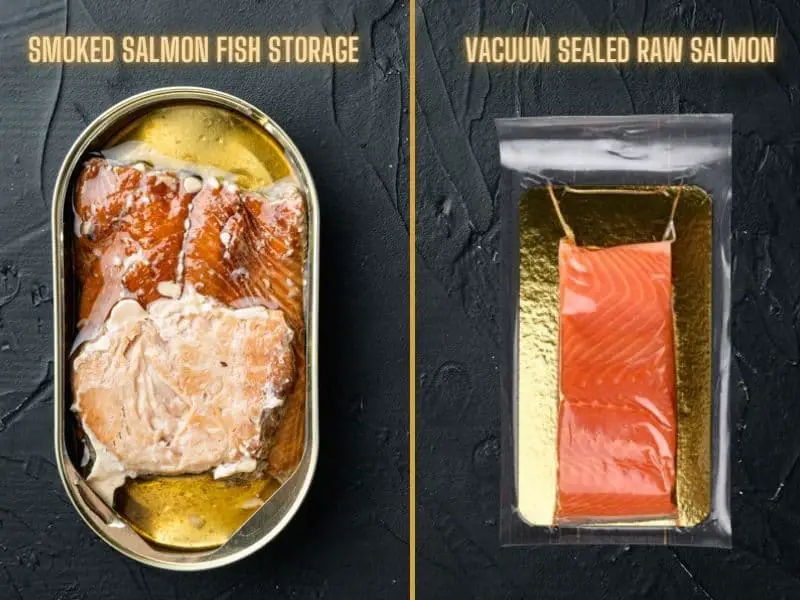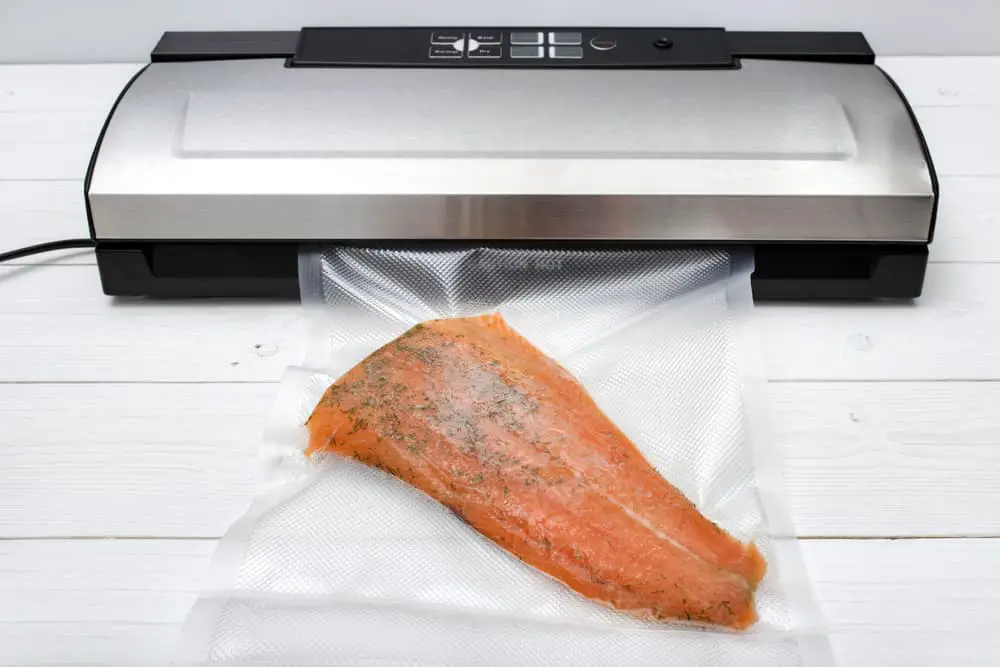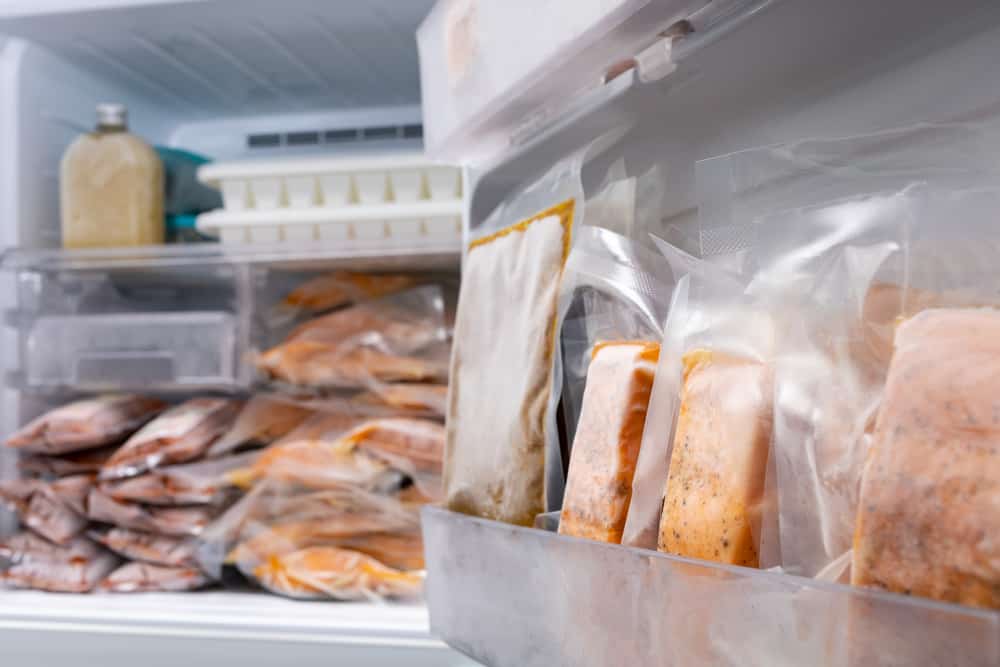Most people use the vacuum sealed process to keep the freshness and taste of fish. However, nobody can guarantee that a vacuum seal can keep fresh food forever. Are you concerned that how long does vacuum-sealed fish last in the fridge?
Remember that raw fish must be fresh, cleaned and dried before sealing in a vacuum pack. Generally, vacuum-sealed raw fish can last longer, up to 2-3 days, in the refrigerator. And smoked vacuum-sealed fish can last longer than 2-3 weeks.
In this guide, you will learn how to store fish in the vacuum-sealed packet in the right ways and how a vacuum-sealed process works.
Is it needed to refrigerate vacuum-sealed fish?
“Yes, it is necessary to vacuum-sealed fish in fridge storage. Because vacuum-sealed doesn’t mean it stays free from getting rotten at any temperature. The vacuum seal works to keep the fish fresh and tasty”
Vacuum sealed raw salmon and smoked salmon fish storage

How long does vacuum packed salmon last? salmon fish is a bit sensitive. It can lose actual taste, flavor and texture if it is not stored properly. Using a vacuum-sealed is important to get a fresh taste from salmon fish—store raw vacuum-sealed salmon in a deep fridge for a longer period. But you can easily store it in normal freeze to eat after 1 or 2 days.
How long does vacuum sealed cooked fish last in the fridge? Vacuum-sealed cooked or smoked salmon storage fish can keep fresh for 2-3 weeks. However, your stored smoked salmon must be well packed and unopened. If you open the vacuum packet once, the freshness may soon decrease.
Proper ways of vacuum sealing

Use a quality vacuum sealer machine:
Fish flesh contains high moisture. So, a good quality vacuum sealer can remove high moisture. However, a Chamber sealer works great to remove excess moisture. Some medium-quality sealer machine offers to seal fish fillet in a different size.
Make sure to use a dry bag:
If you want to ensure a perfect vacuum seal, then ensure your used bag is properly dry. Many used paper towels at 2-3 inches upper and lower of the bag to ensure dryness. Also, carefully enter the fillet so it doesn’t get stuck near the sealing end.
Pre-freeze your fillets:
Pre-freezing helps to reduce maximum fish moisture. As a result, vacuum sealing would be easier and long-lasting. So, keep fish in the freezer in a bag before vacuum sealing.
Soak fillets into the brine to keep strong:
Let your fish soak in brine at least for a few minutes. Statistics have shown that brine-soaking fillets stay stronger in textures than in regular vacuum-sealed fish.
Use a paper towel to dry fillets:
Don’t be hurry to pack the fish in a vacuum-sealed packet. Wipe the fish fillets with a paper towel. Remember as much moisture you can remove from fillets as it will be long-lasting.
Check for bones:
bones coming out from the fillet can damage the vacuum-sealed packet. So, check the fillets once again for sure that there have no bones.
Add seasonings if you want:
Do you like to store fish in marinade condition? Then add your desired spices before vacuum sealing. However, it is recommended to store marinaded fish sometimes in the freezer before vacuum-sealing.
Avoid overfilling:
Never fill a bag with excess fish fillets. Overfilling of fish fillets inside the bag can cause of extra load. As a result, fish can lose real taste and flavor. Moreover, overfilling can damage or tear the bag.
Thaw in the right ways:
Thawing vacuum-sealed fish is a bit tricky. It is recommended to let the vacuum-sealed fish in the normal refrigerator. Never let your vacuum-sealed frozen fish on the kitchen counter.
The disadvantages of vacuum-sealed fish
Although vacuum-sealed fish keep fish fresh and long-lasting, it has some potential disadvantages. Knowing this downside is important if you are thinking of using a vacuum-sealed machine for fish storage.
Expensive:
Vacuum-sealed machine price starts from $50 and goes up to $1000. At the same time, the packaging cost will be added with the machine cost. So, think about how much storage space you have inside the freezer? If there is not enough space to store huge fish, avoid buying a vacuum-sealing machine. Otherwise, your whole investment would go ruined.
Safety:
Usually, a vacuum seal is used to protect fish from bacteria. The main theory of a vacuum-sealed removes oxygen from the packet so bacteria can’t grow without oxygen. But there have some bacteria that can cause without oxygen. When you pack a fish vacuum-sealed, but the fish is not properly clean, bacteria can grow inside. In that case, vacuum-sealed can’t protect the fish. Maybe that fish might be fresh in the freezer with a normal packet more than vacuum packed. So, make sure that your stored vacuum-sealed packet is perfectly clean.
Misconceptions:
Many people think that if they are vacuum-sealed, there is no need to worry about that food. But it is wrong thinking. It is essential to handle vacuum-sealed fish carefully.
It would help if you stored fish in a vacuum-sealed packet at the right temperature. Not only that, a vacuum-sealed fish needs to thaw in the proper ways and at temperature. Otherwise, bacteria can grow inside the packet.
FAQs:
- Can I consume vacuum-sealed fish when the use-by date has passed?
No, it is not recommended to consume any food when it has a use-by date passed. It is safe to consume vacuum-sealed fish if it has passed the sell-by dates. You can safely cook or freeze fish if there has a use-by date on the vacuum-sealed packet. Also, note that fresh frozen fish without a vacuum salad pack can be used for up to 10-12 months.
- How should vacuum-sealed fish be defrosted in the refrigerator?
Preserve vacuum-sealed fish in a deep freeze with less than 38°F temperature. Vacuum sealed fish left out and thaw in the refrigerator overnight. And an overnight is enough for thawing a frost fish. But remember not to defrost it for more than 24 hours. For that reason, you can lose the actual taste and flavor of the fish fillets.
- How long are vacuum-sealed raw tilapia fish stored in the refrigerator and freezer?
Usually, tilapia fish is a lean fish. It stays fresh for 6-8 months if correctly sealed in a plastic bag. However, vacuum-sealed can help to make this fish longer lasting. A vacuum seal can easily keep this tasty fresh for one year in the freezer. And vacuum-sealed fish will stay fresh in the refrigerator for one week.
- Can bacteria grow inside vacuum-sealed fish?
Bacteria can grow inside a vacuum-sealed packet if it is not stored properly. And this type of vacuum-sealed fish can transform into lethal toxins when thawed. If the freezer temperature is more than 38-degree Fahrenheit, Clostridium botulinum type E bacteria can grow. Besides, it can grow up in the absence of oxygen. So, make sure about the freezer temperature before storing a vacuum-sealed fish.
- What are the symptoms that help you know the salmon has gone bad?
Here are some important indications that help you know salmon fish’s condition.
• Textures get slippery
• Mushy appearance
• Strong foul
• The original color starts to turn grey
• Start to spread the bad odor
How long does vacuum sealed tuna last in the fridge?
Vacuum-sealed tuna fish lasts long 2-3 days in the fridge. Although, you will get a sell by date on the package but tuna will still fresh till the used by date. Also note that vacuum-sealed tuna last in freezer up to 2-3 weeks. After then you can eat that tuna fish but the actual taste might lose.
How long does vacuum sealed shrimp last in the fridge?
Vacuum-sealed shrimp last in the fridge up to 1 to two years. Most probably you will get the real taste from vacuum-sealed frozen shrimp after two years.
The end notes:
Vacuum-sealed fish usually stay fresh longer than regular freezing fish. Mostly, a vacuum-sealed can say fresh and flavorful for 2-3 days in the refrigerator. But it can stay fresh for 2-3 weeks. Sometimes, this average time might increase or decrease depending on your storing process. Besides, good quality vacuum sealing is also responsible for keeping the vacuum-sealed fish fresh.

Tony is a professional fishing instructor, and his hobby is fishing! He has been fishing for the last four years, and he loves the fishing instructor profession. Based on his experiences with different types of fishing, he shares his opinion about various fishing techniques so that a beginner can get started right away. Find him on Twitter. Happy reading!

